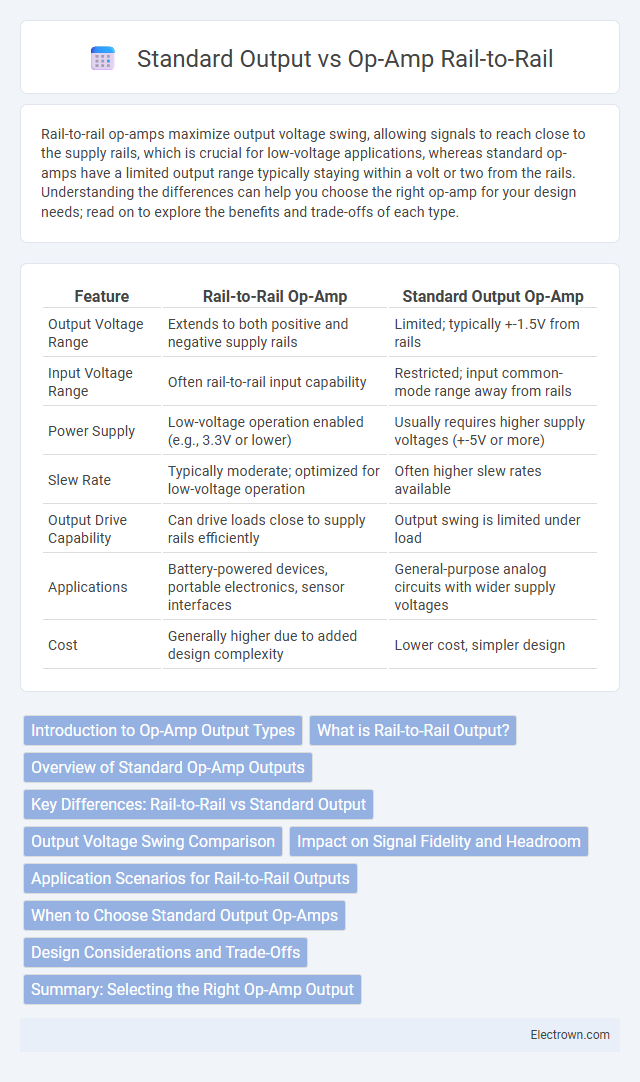Rail-to-rail op-amps maximize output voltage swing, allowing signals to reach close to the supply rails, which is crucial for low-voltage applications, whereas standard op-amps have a limited output range typically staying within a volt or two from the rails. Understanding the differences can help you choose the right op-amp for your design needs; read on to explore the benefits and trade-offs of each type.
Table of Comparison
| Feature | Rail-to-Rail Op-Amp | Standard Output Op-Amp |
|---|---|---|
| Output Voltage Range | Extends to both positive and negative supply rails | Limited; typically +-1.5V from rails |
| Input Voltage Range | Often rail-to-rail input capability | Restricted; input common-mode range away from rails |
| Power Supply | Low-voltage operation enabled (e.g., 3.3V or lower) | Usually requires higher supply voltages (+-5V or more) |
| Slew Rate | Typically moderate; optimized for low-voltage operation | Often higher slew rates available |
| Output Drive Capability | Can drive loads close to supply rails efficiently | Output swing is limited under load |
| Applications | Battery-powered devices, portable electronics, sensor interfaces | General-purpose analog circuits with wider supply voltages |
| Cost | Generally higher due to added design complexity | Lower cost, simpler design |
Introduction to Op-Amp Output Types
Op-amp output types include standard output and rail-to-rail output, each defining how closely the output voltage can approach the supply rails. Standard output op-amps typically cannot drive the output voltage all the way to the power supply limits, resulting in reduced voltage swing and lower signal headroom. Your choice between these output types affects the dynamic range and efficiency in precision applications, especially when operating on low supply voltages.
What is Rail-to-Rail Output?
Rail-to-rail output in an operational amplifier (op-amp) refers to the capability of the output voltage to swing very close to the supply voltage rails, both at the positive and negative extremes. This feature maximizes dynamic range and allows better utilization of the full power supply voltage, especially in low-voltage applications. Standard output op-amps typically have voffset limitations, restricting output swings to within a few volts of the supply rails, reducing available signal range compared to rail-to-rail designs.
Overview of Standard Op-Amp Outputs
Standard op-amp outputs typically swing within a limited voltage range that does not reach the supply rails, resulting in reduced output voltage swing and potential signal distortion near the rails. These outputs rely on transistor stages that cause voltage drop, often limiting the output to about 1.5V below the positive rail and above the negative rail. This behavior contrasts with rail-to-rail op-amps, which utilize specialized output stages to maximize output swing close to the supply voltages, enhancing dynamic range and signal accuracy in low-voltage applications.
Key Differences: Rail-to-Rail vs Standard Output
Rail-to-rail op-amps can output voltages that span nearly the entire supply voltage range, maximizing signal swing and improving performance in low-voltage applications. Standard output op-amps, by contrast, have limited output voltage swing, typically unable to approach the supply rails closely, which reduces the usable dynamic range. Your choice between these types impacts signal accuracy and circuit efficiency, especially in battery-powered or low-voltage systems.
Output Voltage Swing Comparison
Rail-to-rail op-amps achieve output voltage swings that extend very close to the supply rails, typically within millivolts, enabling maximum signal amplitude utilization in low-voltage applications. Standard output op-amps have limited output voltage swing, often saturating a few volts below the supply rails, which reduces the effective dynamic range and signal headroom. The improved output voltage swing of rail-to-rail amplifiers provides enhanced performance in single-supply designs and battery-powered systems requiring maximum output signal range.
Impact on Signal Fidelity and Headroom
Rail-to-rail op-amps maximize signal fidelity by allowing output voltage swings to approach the power supply rails, thus increasing dynamic range and optimizing headroom for low-voltage applications. Standard output op-amps typically have limited output swing, resulting in reduced signal amplitude and decreased usable headroom, which can compromise accuracy in high-precision analog circuits. Choosing a rail-to-rail op-amp enhances your system's performance by ensuring minimal distortion and improved linearity near voltage extremes.
Application Scenarios for Rail-to-Rail Outputs
Rail-to-rail operational amplifiers excel in low-voltage applications requiring maximum output voltage swing close to supply rails, such as battery-powered devices and portable instrumentation. They are ideal for precision sensor interfaces, where signal integrity is critical at low supply voltages, enabling full utilization of the input and output voltage ranges. In contrast, standard output op-amps, with limited output swing, suit scenarios with higher supply voltages or where rail-to-rail performance is unnecessary.
When to Choose Standard Output Op-Amps
Standard output op-amps are ideal when your application involves lower power consumption and less stringent output voltage swing requirements, such as in sensor signal conditioning or audio processing. These devices perform well in systems with sufficient supply voltage headroom, where the output does not need to reach the supply rails. Choose standard output op-amps if your design priorities include cost-effectiveness and stable operation over a wide range of load conditions without the need for rail-to-rail precision.
Design Considerations and Trade-Offs
Rail-to-rail op-amps maximize output voltage range by allowing signals to swing very close to the supply rails, improving dynamic range in low-voltage systems but often increasing distortion and noise. Standard output op-amps typically provide a more linear response and lower distortion within a limited output swing, making them suitable for applications where ultra-wide output range is less critical. Your choice between these designs hinges on the trade-off between maximizing voltage headroom and maintaining signal purity, influenced by factors like power supply constraints and signal processing requirements.
Summary: Selecting the Right Op-Amp Output
Rail-to-rail op-amps maximize output voltage swing by extending as close as possible to the supply rails, ideal for low-voltage and battery-powered applications requiring full signal range. Standard output op-amps have limited output swing, typically staying several volts away from rails, which may restrict dynamic range in precision tasks. Your choice depends on power supply constraints and signal requirements, balancing performance and design complexity.
Op-amp rail-to-rail vs standard output Infographic

 electrown.com
electrown.com